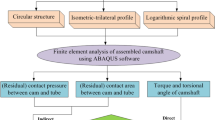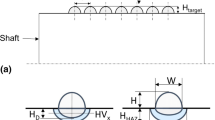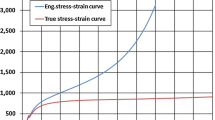Abstract
Interference joint is one of the most advanced assembly methods for camshaft. The joining force in the assembly process and the connection strength after assembly are the key aspects of the camshaft assembly system. In this paper, the mechanism of joining force and connection strength are analyzed from two aspects of elasticity and plasticity using thick-wall cylinder model. Joining and torsion experiments are done to determine the joining force and connection strength. Joining forces fluctuating increase in the joining process, which is composed by friction force Fs and shearing force Ff. Fs is 0.87 KN, and Ff is 6.23 KN when the assembly interference is 0.15mm. Joining force linear increases with the interference, and torque exponential increases with it. The empirical formulas between the torque capacity, joining force, and interference of the camshaft are provided by the experiment results. The assembly interference limit of 0.3mm is estimated for the case of this paper. Metallographic observation reveals the changes of metal flow line of the knurled tube. The top of knurled tooth turns over and an inverted triangle formed after joining process.








Similar content being viewed by others
Data availability
The datasets used or analyzed during the current study are available from the corresponding author on reasonable request.
References
Bonatesta F, Altamore G, Kalsi J, Cary M (2016) Fuel economy analysis of part-load variable camshaft timing strategies in two modern small-capacity spark ignition engines. Appl Energy 164:475–491. https://doi.org/10.1016/j.apenergy.2015.11.057
Hürkamp A, Dér A, Gellrich S, Ossowski T, Lorenz R, Behrens BA, Herrmann C, Dröder K, Thiede S (2020) Integrated computational product and production engineering for multi-material lightweight structures. Int J Adv Manuf Technol 110(9):2551–2571. https://doi.org/10.1007/s00170-020-05895-6
Cicconi P, Landi D, Germani M (2018) An ecodesign approach for the lightweight engineering of cast iron parts. Int J Adv Manuf Technol 99(9):2365–2388. https://doi.org/10.1007/s00170-018-2649-7
Nosrati HG, Gerdooei M (2018) Feasibility study of cam-shaped tube production using elastomeric tool versus fluid forming method. Int J Adv Manuf Technol 95:3029–3036. https://doi.org/10.1007/s00170-017-1425-4
Ma JP, Yang LF, Liu J, Chen ZB, He YL (2021) Evaluating the quality of assembled camshafts under pulsating hydroforming. J Manuf Process 61:69–82. https://doi.org/10.1016/j.jmapro.2020.11.010
Matsumoto R, Hanami S, Ogura A, Yoshimura H, Osakada K (2008) New plastic joining method using indentation of cold bar to hot forged Part. CIRP Ann Manuf Technol 57(1):279–282. https://doi.org/10.1016/j.cirp.2008.03.126
Zhang P, Kou SQ, Li C, Kou ZM (2018) Joint mechanism and prediction of strength for a radial knurling connection of assembled camshaft using a subsequent modeling approach. SAE Int J Engines 3(11):301–310
Mori KI, Bay N, Fratini L, Micari F, Tekkaya AE (2013) Joining by plastic deformation. CIRP Ann Manuf Technol 62:673–694. https://doi.org/10.1016/j.cirp.2013.05.004
Zhao J, Wang JX, Yu C, Tang SQ, Yao J (2019) Influence of radial interference on torque capacity of shrink-fit camshaft. Adv Mech Eng 11(4):1–10. https://doi.org/10.1177/1687814018817640
Weddeling C, Woodward ST, Marré M, Nellesen J, Psyk V, Tekkaya AE, Tillmann W (2011) Influence of groove characteristics on strength of form-fit joints. J Mater Process Technol 211:925–935. https://doi.org/10.1016/j.jmatprotec.2010.08.004
Kleditzsch S, Lätzer M, Awiszus B, Leidich E (2014) Numerical investigation of knurled shaft-hub connections and especially of the joining process. Mater Sci Forum 773(18):18–27. https://doi.org/10.4028/www.scientific.net/MSF.773-774.18
Kleditzsch S, Awiszus B, Lätzer M, Leidich E (2015) Numerical and analytical investigation of steel–aluminum knurled interference fits: joining process and load characteristics. J Mater Process Technol 219:286–294. https://doi.org/10.1016/j.jmatprotec.2014.12.019
Zhang P, Kou SQ, Lin BJ, Wang YM (2015) Optimization for radial knurling connection process of assembled camshaft using response surface method. Int J Adv Manuf Technol 77:653–661. https://doi.org/10.1007/s00170-014-6486-z
Sen S, Aksakal B (2004) Stress analysis of interference fitted shaft-hub system under transient heat transfer conditions. Mater Design 25(5):407–417. https://doi.org/10.1016/j.matdes.2003.11.009
Cao R, Li L, Zhang J, Chen JH (2010) Internal stress analysis of interference fittings of TiAl turbine shaft and K418 alloy sleeve. Phys Test Chem Anal 46:552–556
Luo Y, Wang XD, Wang MX, Tan DB, Zhang T, Yang YC (2013) A force/stiffness compensation method for precision multi-peg-hole assembly. Int J Adv Manuf Technol 67:951–956. https://doi.org/10.1007/s00170-012-4539-8
Kim J, Kim SW, Park HJ, Kang BS (2006) A prediction of bursting failure in tube hydroforming process based on plastic instability. Int J Adv Manuf Technol 27:518–524. https://doi.org/10.1007/s00170-004-2204-6
Song WJ, Kim SW, Kim J, Kang BS (2005) Analytical and numerical analysis of bursting failure prediction in tube hydroforming. J Mater Process Technol 164:1618–1623. https://doi.org/10.1016/j.jmatprotec.2005.01.008
Watson M, Long H, Lu B (2015) Investigation of wrinkling failure mechanics in metal spinning by Box-Behnken design of experiments using finite element method. Int J Adv Manuf Technol 78(5):981–995. https://doi.org/10.1007/s00170-014-6694-6
Zhao YH, Li QH, Li FG, Wang CP (2012) Research on grading expanding process and crack for rings. China Metalforming Equipment & Manufacturing Technology 1:79–83
Ben NY, Zhang DW, Liu N, Zhao XP, Guo ZJ, Zhang Q, Zhao SD (2017) FE modeling of warm flanging process of large T-pipe from thick-wall cylinder. Int J Adv Manuf Technol 93:3189–3201. https://doi.org/10.1007/s00170-017-0739-6
Ran JQ, Zhang GQ, Chen GP, Wang JL, Deng BL, Kuz’min MP, Xu T, Gong F (2020) A multi–strain-rate damage model on fracture prediction in single-point diamond turning process. Int J Adv Manuf Technol 110(9):2753–2765. https://doi.org/10.1007/s00170-020-06023-0
Guo XZ, Xiong H, Xu Y, Elaty AA, Ma YN, Zhao YH, Zhang SH (2018) U-R relationship prediction method for aluminum alloy circular tube free-bending process based on sensitivity analysis of material parameters. Int J Adv Manuf Technol 99(5):1967–1977. https://doi.org/10.1007/s00170-018-2614-5
Wen BC, Huang WH, Tan JR (2010) Mechanical design manual. Machinery Industry Press, Beijing
Yang GM, Coquille JC, Fontaine JF, Lambertin M (2002) Contact pressure between two rough surfaces of a cylindrical fit. J Mater Process Technol 123:490–497. https://doi.org/10.1016/S0924-0136(02)00139-5
Blanchard P, Nigarura S, Trasorras J, Wordsworth R (2000) Assembled camshaft with sintered cam lobes: torsional fatigue strength and wear performance. SAE 2000 World Congress. https://doi.org/10.4271/2000-01-0397
Funding
This work was funded by the Natural Science Foundation of Shandong Province (No. ZR2016EEP04).
Author information
Authors and Affiliations
Contributions
The author contributions are as follows: Xiaoming Huang was in charge of the whole trial and designed the study; Xiaoming Huang and Wentao You wrote and edited the manuscript; Weitao Sun and Yuqian Wang assisted with sampling and laboratory analyses; Xiaoliang Liu and Yucan Wang provided guidance and discussion in theory; Jin Xing and Hailin Bi performed the experiments. All authors read and approved the final manuscript.
Corresponding author
Ethics declarations
Ethical approval
Ethics approval was not required for this research.
Consent to participate
Not applicable.
Consent to publish
This work has not been submitted and not been published previously, is not under consideration for publication elsewhere, and is approved and wish to be considered for publication in The International Journal of Advanced Manufacturing Technology by all authors.
Competing interests
The authors declare no competing interests.
Additional information
Publisher’s note
Springer Nature remains neutral with regard to jurisdictional claims in published maps and institutional affiliations.
Rights and permissions
About this article
Cite this article
Huang, X., Sun, W., Liu, X. et al. Analysis on the interference assembly of camshaft with knurled tube and cam. Int J Adv Manuf Technol 117, 961–969 (2021). https://doi.org/10.1007/s00170-021-07783-z
Received:
Accepted:
Published:
Issue Date:
DOI: https://doi.org/10.1007/s00170-021-07783-z




